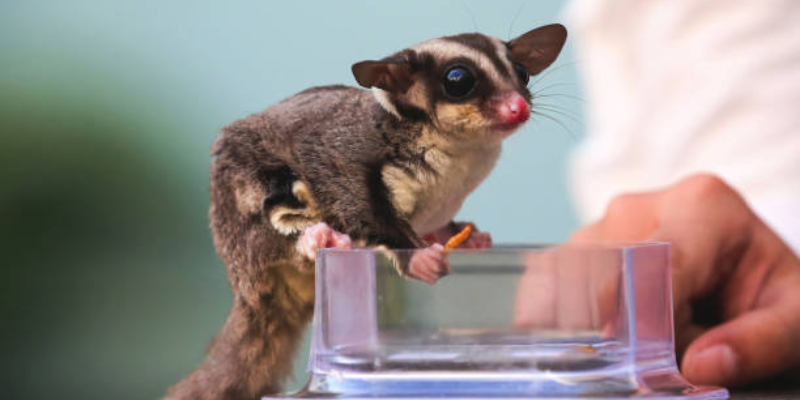If you’ve ever perused pet videos online, you’ve likely seen sugar gliders. These pint-sized, wide-eyed animals are like a cross between a squirrel and a superhero. They fly through the skies, snuggle with their owners and can fit in the palm of your hand. But are they good pets? As someone who’s spent countless hours Googling these marsupials, let me guide you through everything you need to know.
Why Heart-Stealing Sugar Gliders
Sugar gliders are unique. They're sociable and playful and create strong bonds with their humans. Picture coming home to a pet that chirps excitedly at you when you enter the room. They're nocturnal and are most active at night — great if you're a night owl. Apartment dwellers and people with limited space also find them perfect because of their small size.

But their most endearing quality is their loyalty. Once bonded, sugar gliders are happy to curl into pockets or pouches as you go about your day. They're relentlessly curious explorers, as well. Seeing them approach puzzles or manoeuvre obstacle courses can be like having a little acrobat in your home.
The Reality Of Daily Care
Before you fall in love, let's discuss the work. Sugar gliders are not low-maintenance pets. They need a lot of attention. They live in colonies in the wild, so they need companionship. Experts suggest at least two sugar gliders should be kept together to minimize loneliness. If you're their sole counterpart, you must devote hours daily to playtime and connecting.
Considerable consideration number two is their cage. A little cage is a recipe for disaster. Sugar gliders are climbers, high jumpers, and gliders, so you need a pretty big living space for them—we're talking at least 120 cm in height for two gliders. Provide branches, toys, and nesting pouches for foraging and exercising. The cage should also be cleaned regularly since neglecting hygiene can lead to health problems.
The Human Diet: What Do They Eat?
Sugar gliders also have specific dietary requirements. In the wild, they dine on sap, insects and nectar. There's a work involved in replicating this in captivity. Owners who give their birds commercial pellet mixes can supplement with fresh fruits and vegetables and a protein source like mealworms or cooked eggs.
Do you have a calcium deficiency? If they don’t get enough calcium, their bones weaken and painful injuries result. A healthy diet takes time and effort to research and plan! You can’t give them the carrot and call it a day.
Bonding: Patience Is Key
It will take time to build trust with a sugar glider. When you first adopt one, it may be skittish or nippy. First, begin by feeding treats from your hand. Cut back on handling sessions, make them short, and do not give them too much Stress. Eventually, over weeks or months, they'll learn that you see them as a safe space.
Bonding is not a single, one-off task. Daily interaction is critical even after trust is built. Failing to do so can result in behavioural problems, including aggression or excessive grooming.

Health Hurdles To Watch For
Sugar gliders are susceptible to several health problems, many of which concern diet or Stress. They become obese if they are overfed or understimulated. Malnutrition can result in muscle wasting or organ failure. Annual vet visits are critical, but finding veterinarians trained in exotic animals can be challenging and costly.
Parasites, infections, and dental problems are also regularly mentioned. Fluffy enjoys helping her mom make chew toys for our friends because rodent teeth grow continuously.
The Lifespan Factor
The average lifespan of sugar gliders is 12–15 years. That's more than double the lifespans of most small pets, such as hamsters or guinea pigs. This is great when you have dedicated owners, but it is also a huge responsibility. You'll have to arrange for their care, whether that's during vacations, job changes, or moves. They're not some puppy you can take home on a whim and then leave in a closet.
Are They Legal Where You Live?
Check local laws before bringing one home. Others consider sugar gliders a potential invasive species and have banned their ownership. Permits may be needed, adding another layer of complexity.
Sugar Gliders Are Highly Social Animals
These animals are social and do best in pairs or groups. Adopt two if you can't give constant companionship. They groom one another, play with one another and accompany one another. A lone sugar glider can become depressed, and this can cause a variety of health and behaviour problems.
Noise And Nighttime Activity
Sugar gliders are nocturnal. They’ll scurry around their cage, make noises, glide when you’re trying to sleep. They tend to make noise, but it’s not loud; light sleepers may find this disruptive. If you work nights, their schedule meshes with yours. Otherwise, brace yourself for the late-night shenanigans.
The Cost Of Care
Set-up costs include a cage, bedding, food, and vet bills. Over the years, food, toys, medical care, and other expenses accumulate. Emergencies, such as fractures or infections, can cost hundreds of dollars. Many pet insurance plans do not cover exotic pets, making them hard to find, so saving up for emergencies makes sense.
Should You Get a Sugar Glider?
Once you’ve listed all the pros and cons, ask yourself:
Am I free to play with my pet for 2–3 hours daily?
Can I afford to get a large cage and exceptional food?
“Do I want to commit to this for the next 15 years?
Will I investigate to locate a knowledgeable exotic veterinarian?
If so, a sugar glider could make a rewarding companion. If not, look for a lower-maintenance pet.
Ready To Begin Your Journey?
Sugar gliders aren't for everyone, but they are a joy if you're an incredibly dedicated owner. They are undoubtedly one-of-a-kind pets with charming personalities and loving temperaments. But remember , ownership is a marathon, not a sprint. With love, patience and the proper prep, you'll develop a bond for life.




